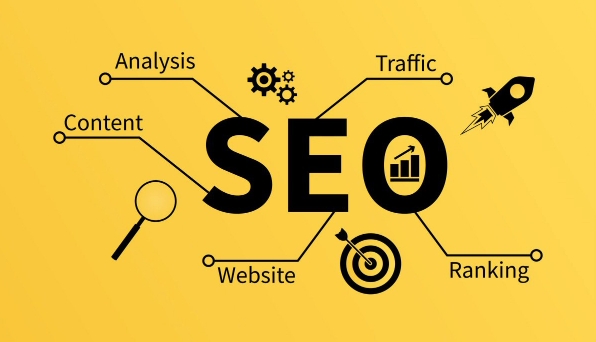SEO for e-commerce websites involves attracting the right visitors through technical setup, content strategy, and optimization. First, optimize product pages by conducting keyword research, using keywords naturally in titles, descriptions, URLs, and subheadings, writing unique benefit-driven descriptions, and including keyword variations. Second, improve site speed and technical SEO by compressing images, leveraging browser caching, fixing broken links, and ensuring mobile-friendliness. Third, build high-quality backlinks by creating useful content like guides and infographics, partnering with influencers, listing on comparison sites, and getting featured in roundups. Fourth, take advantage of structured data and rich snippets by adding schema markup in JSON-LD format, encouraging customer reviews, and using plugins to simplify implementation. These steps enhance visibility, user experience, and conversions.

SEO for an e-commerce website isn’t just about getting more traffic—it’s about attracting the right kind of visitors who are likely to buy. The key is combining technical setup, content strategy, and smart optimization to make your products easy to find and appealing to both search engines and shoppers.

Optimize Product Pages for Keywords
Most people start their shopping journey with a search query. That means each product page should be built around specific keywords that match what users are typing into Google.

- Do keyword research: Use tools like Ahrefs, SEMrush, or even Google’s Keyword Planner to find relevant terms with decent search volume and manageable competition.
- Use keywords naturally: Place your main keyword in the product title, description, URL, and at least one subheading. Don’t force it—readability matters.
- Write unique descriptions: Avoid copying manufacturer text. Write original, benefit-driven content that answers questions a buyer might have.
- Include variations: If you sell “wireless Bluetooth headphones,” also mention related phrases like “noise-canceling wireless earbuds” or “Bluetooth earphones for running.”
A well-optimized product page doesn’t just rank better—it converts better too.
Improve Site Speed and Technical SEO
E-commerce sites often suffer from bloated pages, slow load times, and messy site structures. Fixing these issues can have a big impact on rankings and user experience.

Here’s what to focus on:
- Compress images: Large image files are one of the biggest slowdown culprits. Use tools like TinyPNG or Squoosh to compress without losing quality.
- Leverage browser caching: This allows returning visitors to load pages faster by storing parts of your site locally.
- Fix broken links: Regularly scan your site using tools like Screaming Frog or Google Search Console to catch 404 errors.
- Make sure your site is mobile-friendly: More than half of all online shopping happens on mobile devices. Test your site with Google’s Mobile-Friendly Test tool.
Google rewards fast, clean websites. If your site feels sluggish or disorganized, it’s time to clean up the backend.
Build High-Quality Backlinks
Backlinks are still a major ranking factor. For e-commerce sites, earning natural links can be tricky—but not impossible.
Try these tactics:
- Create useful content: Think beyond product pages. How-to guides, buying guides, and niche infographics can attract links from bloggers and influencers.
- Partner with influencers or bloggers: Offer free samples or affiliate deals in exchange for honest reviews or mentions.
- List your products on comparison sites: Platforms like PriceGrabber or Shopzilla can drive referral traffic and sometimes backlinks.
- Get featured in roundups: Reach out to bloggers who publish “best of” lists in your niche and pitch your products.
It takes time, but consistent outreach and valuable content will help build a strong backlink profile.
Take Advantage of Structured Data and Rich Snippets
When your product shows up in search results with star ratings, price, and availability, it stands out—and gets more clicks. That’s the power of structured data.
What you can do:
- Add schema markup to your product pages to tell search engines exactly what’s on the page—like price, availability, and reviews.
- Encourage customer reviews—they feed into rich snippets and boost credibility.
- Use JSON-LD format, which is recommended by Google and easier to implement than other formats.
Many e-commerce platforms (like Shopify or WooCommerce) have plugins that simplify this process, so don’t feel like you need to code everything yourself.
That’s basically how you start doing effective SEO for an e-commerce site. It’s not magic—it’s attention to detail, consistency, and focusing on what helps real users. Some parts take more effort than others, but skipping them usually shows in your traffic and sales.
The above is the detailed content of How to do SEO for an e-commerce website. For more information, please follow other related articles on the PHP Chinese website!

Hot AI Tools

Undress AI Tool
Undress images for free

Undresser.AI Undress
AI-powered app for creating realistic nude photos

AI Clothes Remover
Online AI tool for removing clothes from photos.

Clothoff.io
AI clothes remover

Video Face Swap
Swap faces in any video effortlessly with our completely free AI face swap tool!

Hot Article

Hot Tools

Notepad++7.3.1
Easy-to-use and free code editor

SublimeText3 Chinese version
Chinese version, very easy to use

Zend Studio 13.0.1
Powerful PHP integrated development environment

Dreamweaver CS6
Visual web development tools

SublimeText3 Mac version
God-level code editing software (SublimeText3)

Hot Topics
 Are we becoming less curious about SEO?
Jul 07, 2025 am 09:12 AM
Are we becoming less curious about SEO?
Jul 07, 2025 am 09:12 AM
I noticed that a strong comment from Google’s VP of Search, Hyung-Jin Kim, at SMX Next in November 2022 has largely gone unnoticed by the SEO community up to now.He stated (my emphasis):“E-A-T is a template for how we rate an individual site. We do i
 What we're seeing a week into the Google March 2024 core and spam updates
Jul 07, 2025 am 09:16 AM
What we're seeing a week into the Google March 2024 core and spam updates
Jul 07, 2025 am 09:16 AM
We are now just about a week into the Google March 2024 core and spam updates, and boy, has it been busy. In that time, we have seen search ranking volatility, some related to the algorithmic updates and some related to Google issuing manual actions
 Google AI overviews launch in UK
Jul 02, 2025 am 10:07 AM
Google AI overviews launch in UK
Jul 02, 2025 am 10:07 AM
Google’s AI overviews are beginning to appear in search queries for a “small slice” of logged-in users in the UK. Google’s Search Generative Experience has been in testing as a Labs experiment in the U.S. since May 2023. SGE h
 Bing Deep Search is officially live for all users
Jul 05, 2025 am 09:32 AM
Bing Deep Search is officially live for all users
Jul 05, 2025 am 09:32 AM
Bing Deep Search, an optional generative AI feature designed to assist users with complex questions that lack straightforward answers, is now fully available to all users. Microsoft has announced that the Deep Search function within Bing Search can n
 Is ChatGPT the Google Search killer we've been expecting?
Jul 05, 2025 am 09:14 AM
Is ChatGPT the Google Search killer we've been expecting?
Jul 05, 2025 am 09:14 AM
AltaVista. Lycos. Yahoo. Once upon a time, these were the most popular search engines in the world. Then along came Google. It did Search better. Since around 2002, Google has been the search engine – and its dominance has only grown year after
 Google starts testing AI overviews from SGE in main Google search interface
Jul 05, 2025 am 09:33 AM
Google starts testing AI overviews from SGE in main Google search interface
Jul 05, 2025 am 09:33 AM
Google is currently trialing AI overviews directly within the standard Google Search results, even for users who haven't signed up for the Google Search Generative Experience (SGE) Labs feature. According to a Google spokesperson speaking to Search E
 Mikhail Parakhin, head of Microsoft Bing Search and Microsoft Advertising steps down
Jul 05, 2025 am 09:15 AM
Mikhail Parakhin, head of Microsoft Bing Search and Microsoft Advertising steps down
Jul 05, 2025 am 09:15 AM
Mikhail Parakhin is leaving his position as the head of Bing Search and Microsoft Advertising, potentially moving into a different role within the company. “Mikhail Parakhin, who leads the company’s Bing search engine and advertising divisions, will
 4 keys to SEO and PPC collaboration in 2024
Jul 06, 2025 am 09:27 AM
4 keys to SEO and PPC collaboration in 2024
Jul 06, 2025 am 09:27 AM
Every year brings a ton of change in digital marketing. In each of my 10 years in the industry, I’ve noticed that the beginning of the year can mark a surge in calls for SEO and PPC to work together.The difference in 2024? There’s an elephant in the






